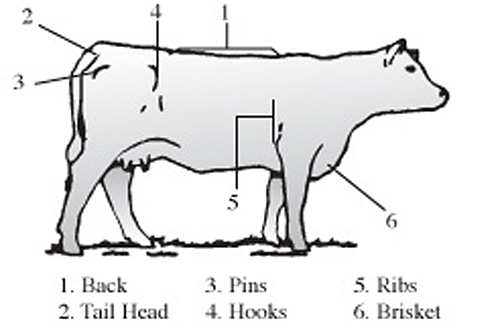 |
Pak Dairy Info
Pakistan's 1st Online Dairy Farming Guide |
Home || Our Team || Dedication || Acknowledgement || Downloads || Articles || Site Map || References || Contact Us || Feedback ![]()
|
||||||
| Record Keeping | ||||||
|
||||||
|
||||||
|
Importance in Dairy Animals Body condition scoring is a subjective method for estimating the quantity of subcutaneous fat in specific anatomical regions on a live animal. Actual body condition scores (BCS) and changes in scores over time enable the farmer/supervisor to estimate the impact of various management practices, especially the efficiency of nutrition on reproduction, production of milk and on health. Scoring body condition enables farmers to estimate and compare the body conditions in various production groups and how much body tissue is lipolized during the transition period . Thus, body condition scoring is an important tool in daily management of dairy animals. Methodology Body condition is scored on a scale of 1 to 5. In dairy animals, a change in BCS is related to both liveweight change and a change in body tissue reserves. A score of 1 indicates severe underconditioning and a score of 5 is assigned to very obese animals. Quarter and half scores, sometimes expressed as pluses and minuses can be added to refine scoring system. With one system, relevant parts of back and rump of the dairy animal are palpated to determine the amount of fat tissue covering these areas. With another system, the same relevant parts of the animal are visually appraised. In scoring body condition, particular attention is given to tissue covering the vertebral spinous processes and transverse processes of the lumbar vertebrae, tuber coxae (hooks), tuber oschii (pins), and tissue depressions between the backbone and the hook and pin bones. Also, the slope between hook and pin bones and the hollowness between tailhead and pin bones are evaluated. All these areas must be considered for each animal. Using 1 or 2 areas can be misleading. For accurate scoring, animal must be standing. Frame size, breed, stage of lactation, milk production level, and health status must be ignored for accurate scoring.
In short, it can be stated that score 1 represents animals that are emaciated with a skinny and bony appearance. A high producing, early lactation animal should have a score not lower than 2.5. A buffalo or cow with a score of 2 or lower in early lactation indicates a shortage in dry matter/energy intake at an earlier stage. A milking buffalo or cow in good condition is represented by score 3. Dry dairy animals should score 3.25 to 3.5. Score 4 represents an overconditioned animal. A score of 5 makes a dairy animal a prime candidate for fat cow syndrome. Body condition scoring should be performed every 4 weeks for dry animals and every 4 to 6 weeks after calving. Young stock should be scored at regular intervals of 2 months. Condition can change very rapidly around puberty. Therefore, this time period should be monitored carefully. Pregnant heifers from about 2 months before parturition can be scored at the same time as dry animals. BCS should be recorded on recording sheets. This offers opportunity to follow condition scores of individual buffaloes/cows over time. BCS of individual animals during the dry period should be put on the examination list within the frame work of herd fertility programme. Clinical findings can be related with changes in body condition.
Dry Period: Generally, an overconditioned animal is at an increased risk of calving problems, reduced feed intake, severe condition loss, and a complex of metabolic, digestive, reproductive, and infectious diseases. Overconditioned animals often have a history of diseases in previous lactation such as mastitis or infertility and are often dried off early, leading to extended dry periods which may result in a vicious circle. Most of these problems can be avoided in the future, if dairy animals are fed balanced late-lactation and dry-animal rations. It is not advisable to reduce body weight during the dry period. This will lead to mobilization of fat from body tissues, deposition of fat in the liver, and all the associated metabolic problems. Thus, it is important for the dairy farmer to strike a balance between allowing animals to be too fat or too thin at calving and also to monitor body condition changes after calving in order to feed them properly.
Early Lactation:
Mid-Lactation:
Late Lactation: Research findings and field data suggest that the degree of changes in body condition after calving influence health, reproduction, and productivity in dairy animals more than the BCS at calving. Current body condition scores reflect previous energy balance, whereas changes in body condition after calving may be associated with a higher incidence of fatty liver, impaired fertility, and other health problems.
|
||||||
|
Copyrights © Dr. M Jassar Aftab, All Rights Reserved |
||||||



